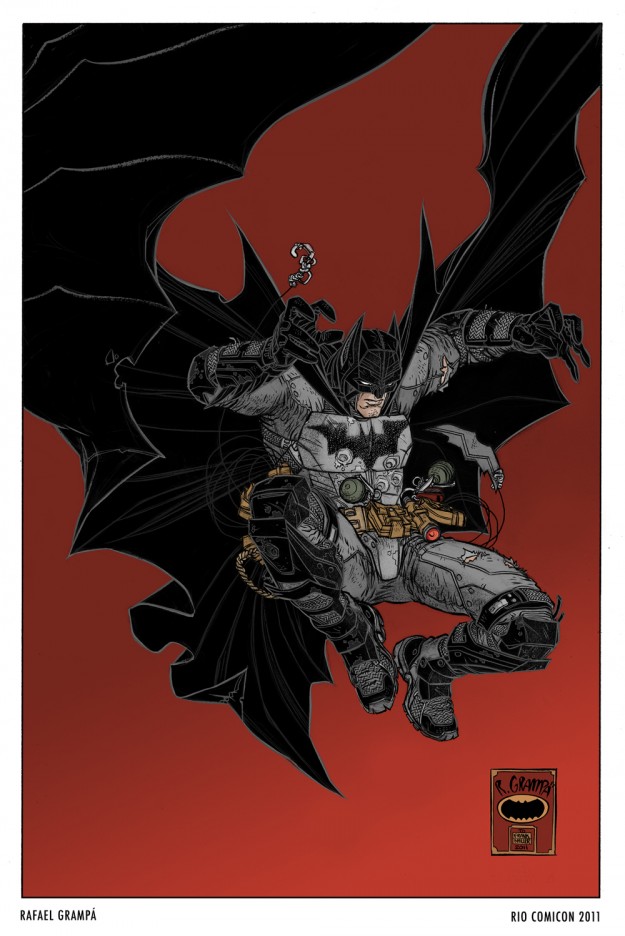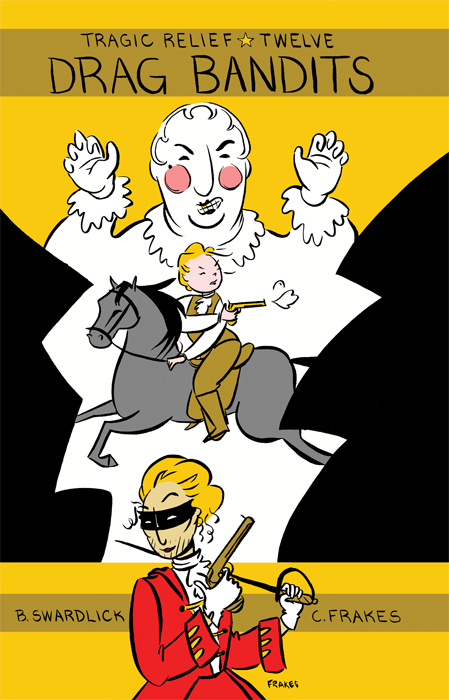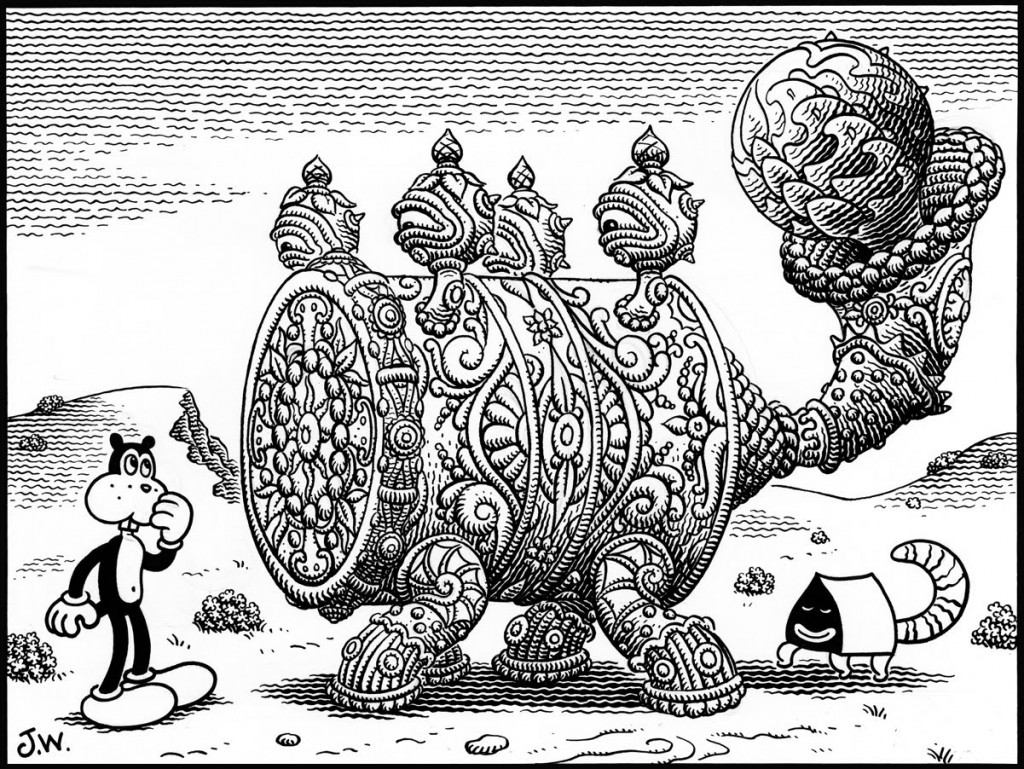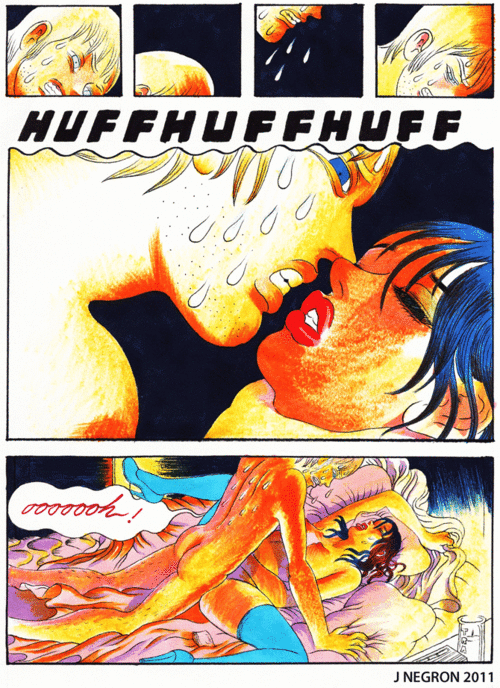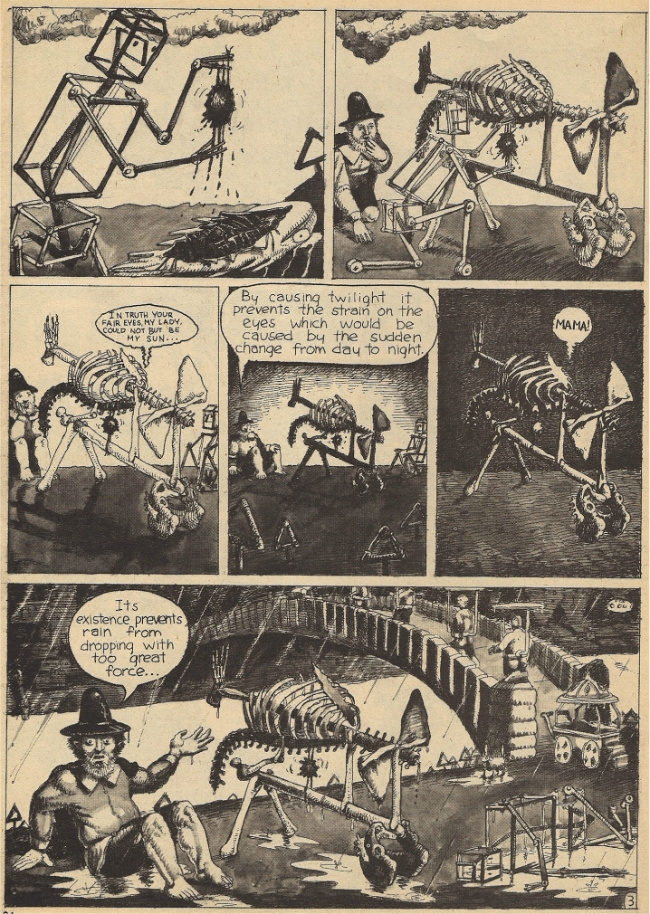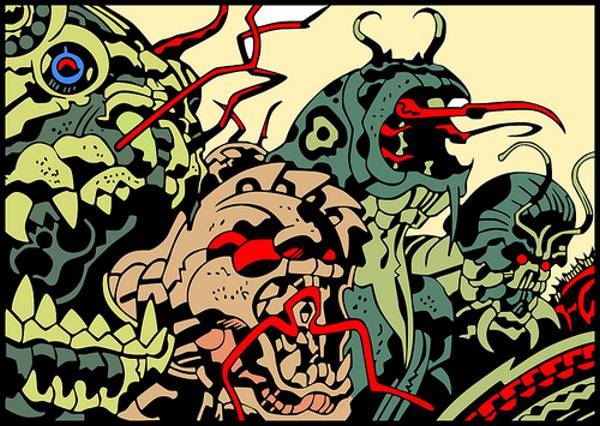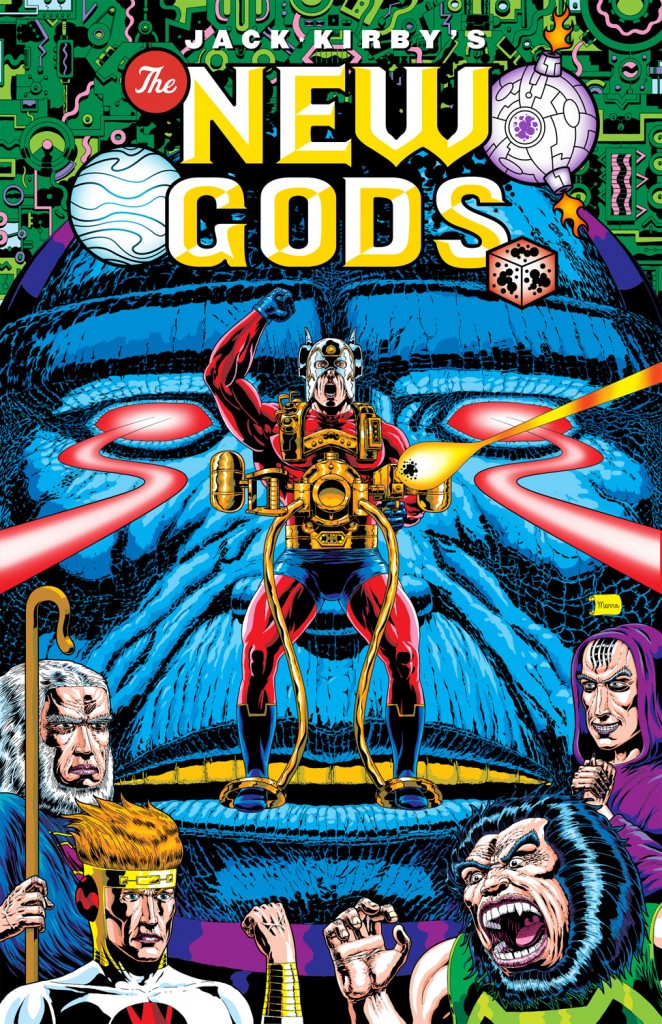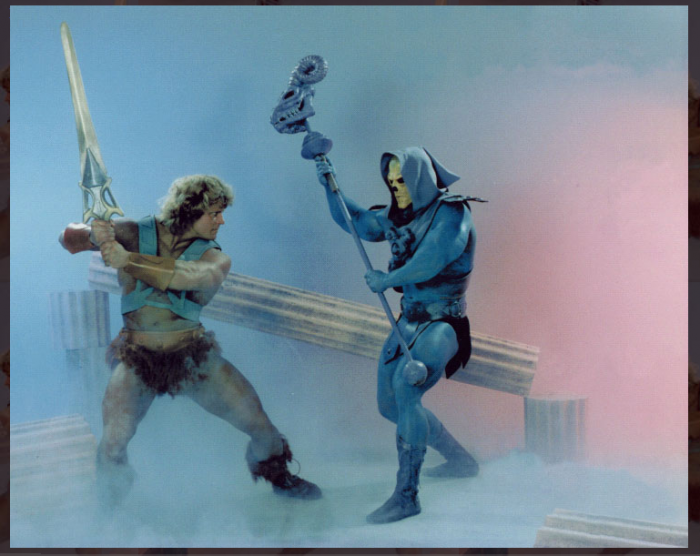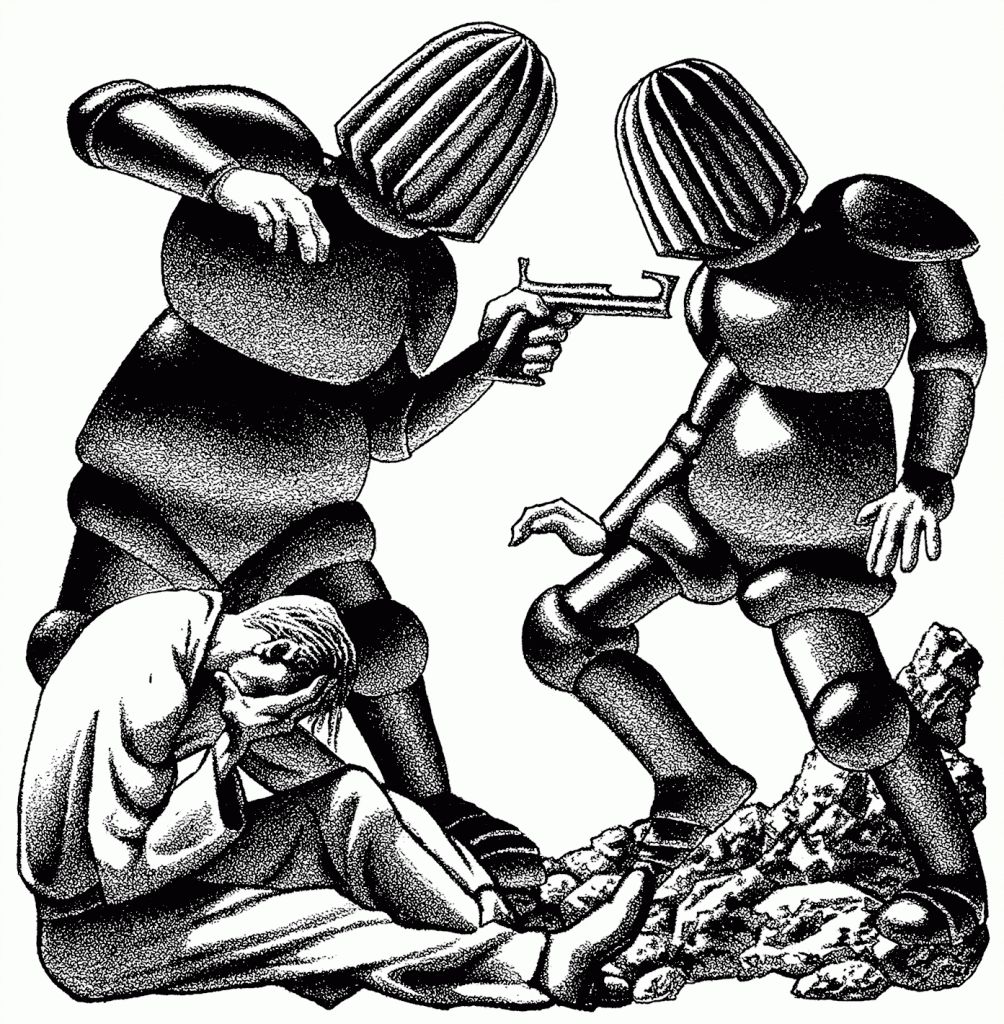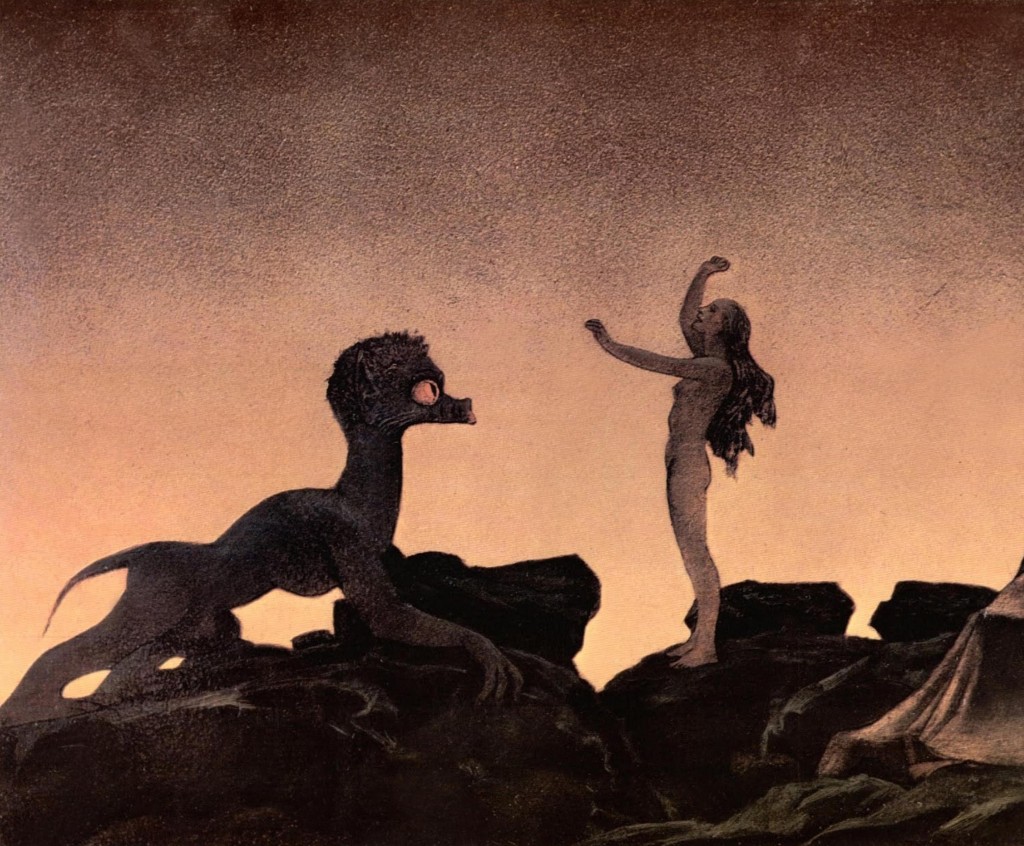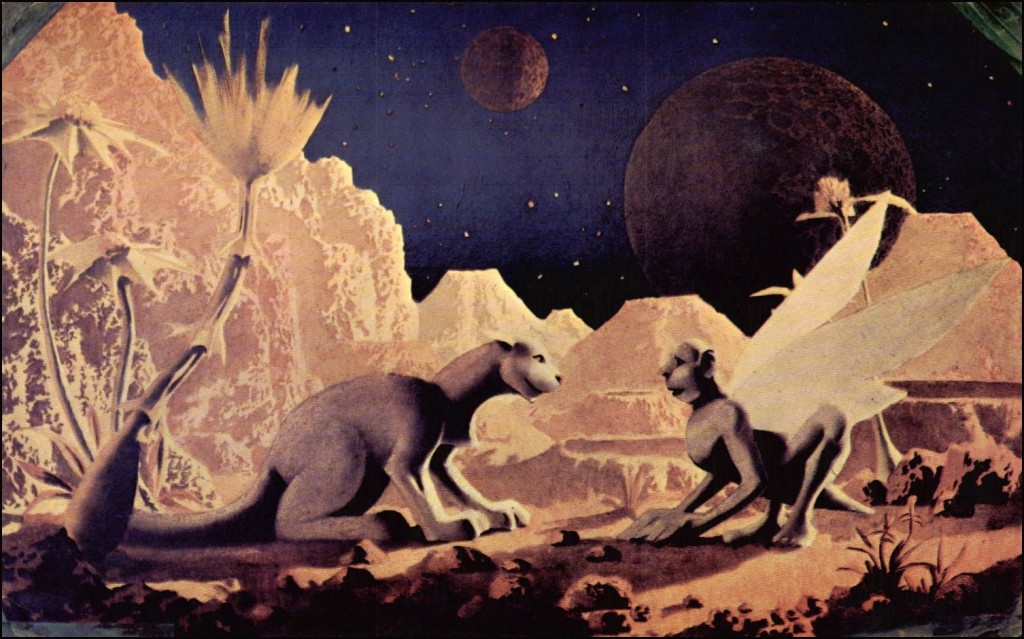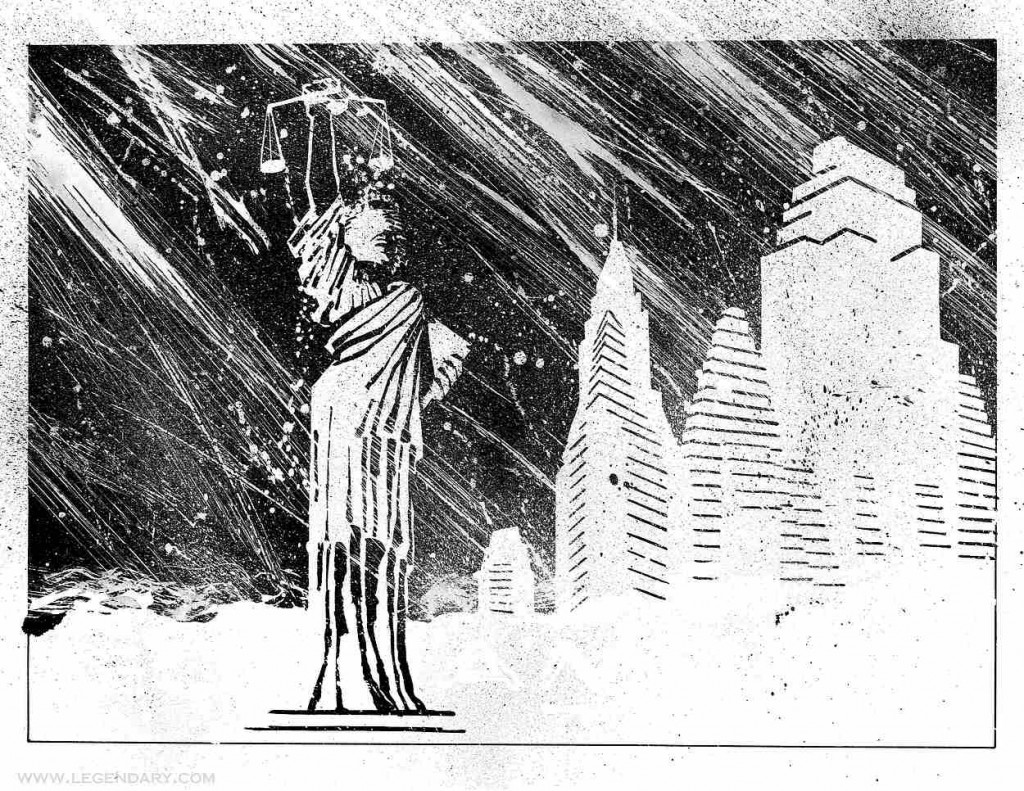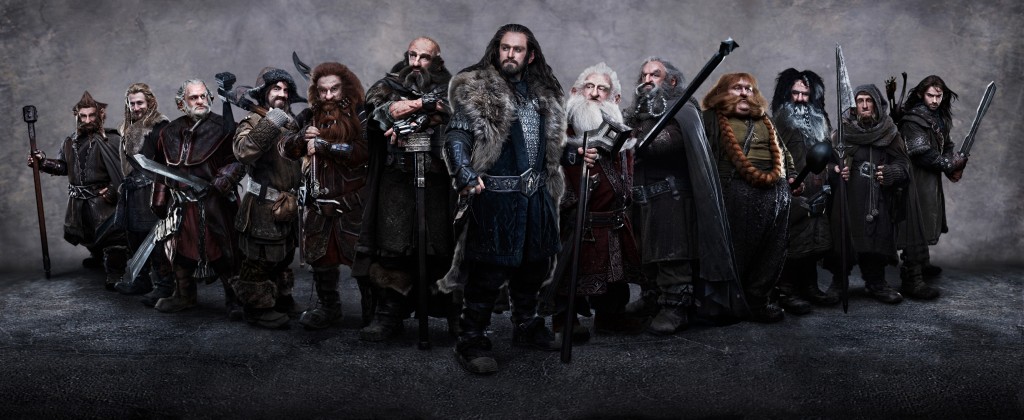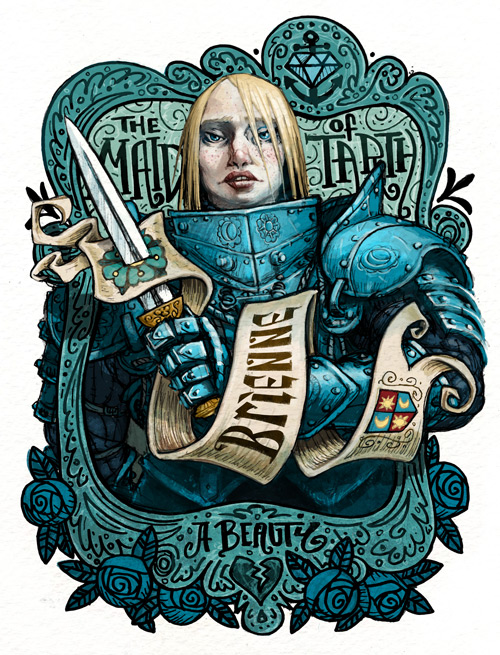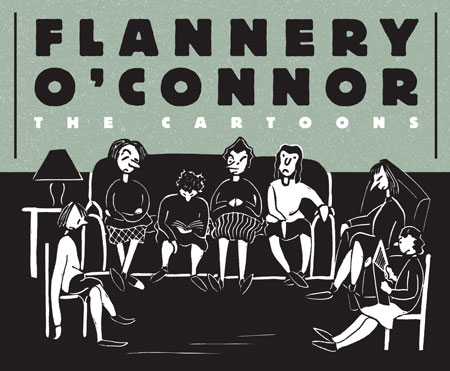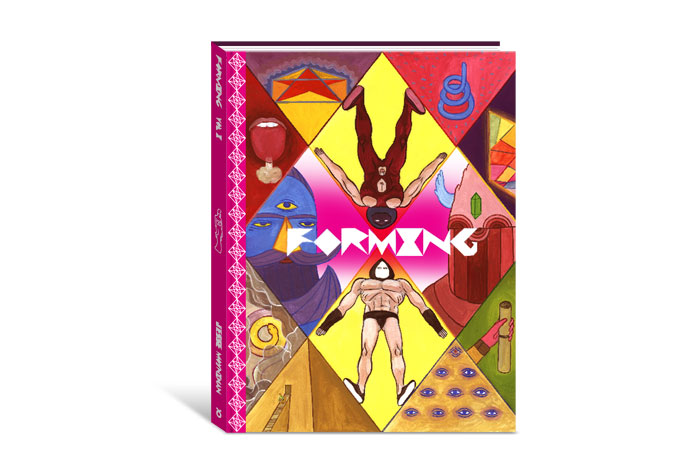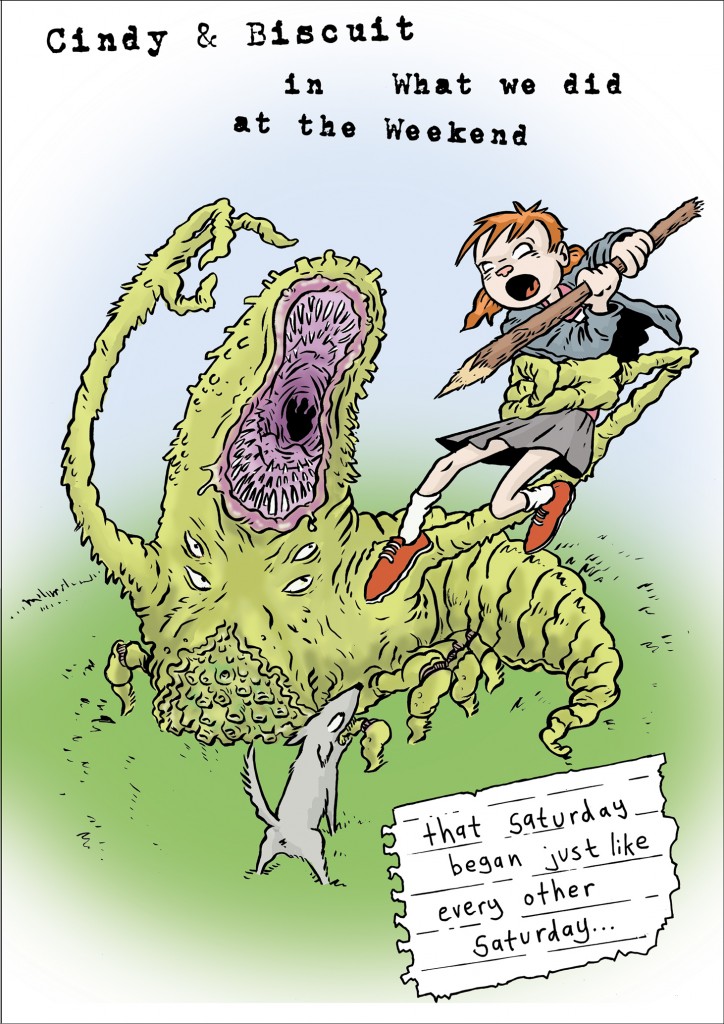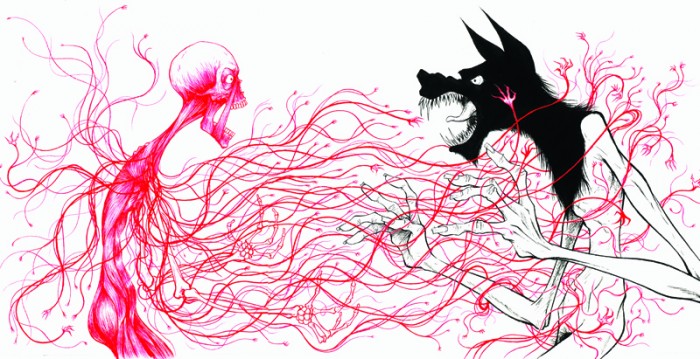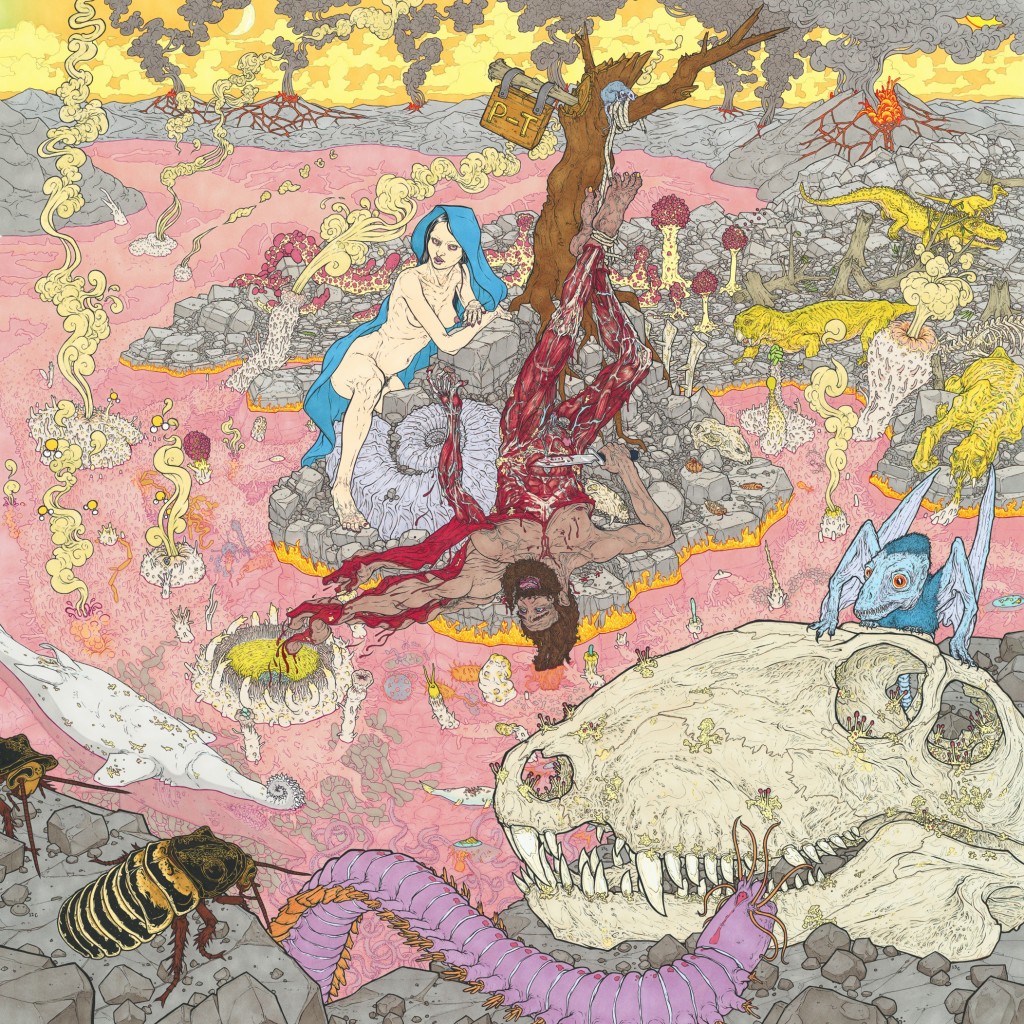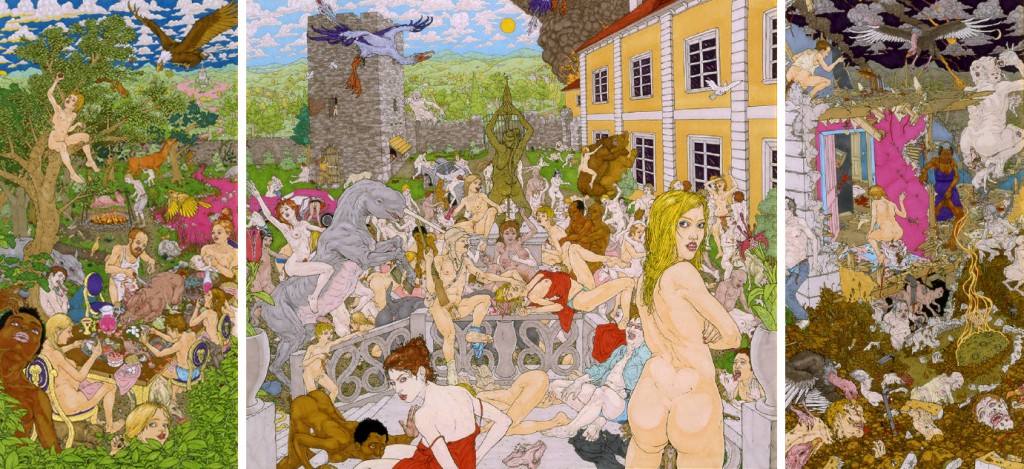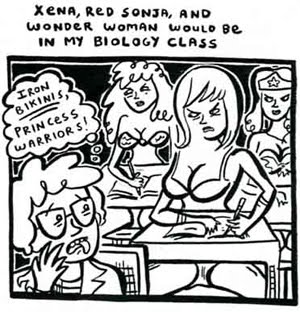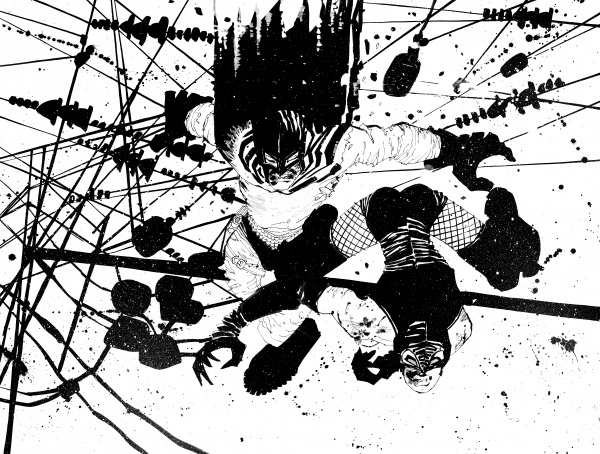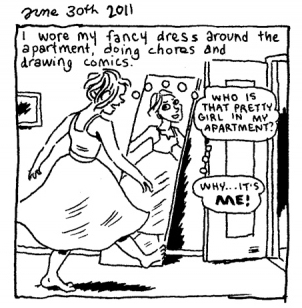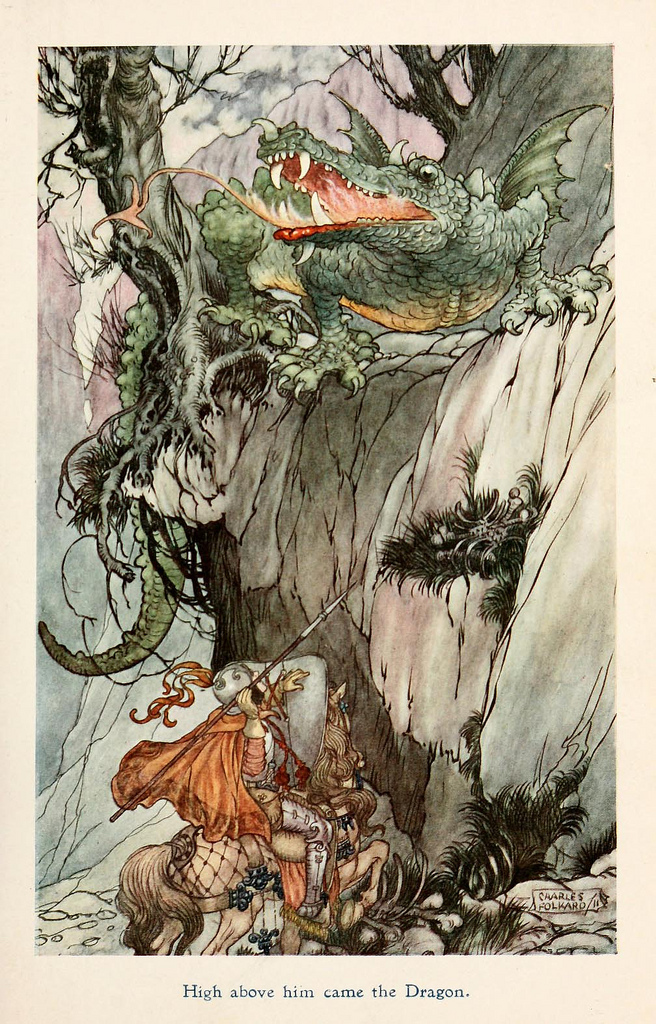Posts Tagged ‘books’
Carnival of souls: Sparkplug, Netflix, Partyka at the Whitney, more
October 12, 2011* Sparkplug Comic Books will continue, under the watch of Dylan Williams’s wife Emily Nilsson, his friend Tom Neely, and his colleague Virginia Paine. They haven’t decided whether or when they’ll be able to start publishing new work, though they’d like to, but they’re continuing to sell and promote the company’s existing, excellent line-up.
* Amazingly, Netflix has backed down off its previously announced plan to divert its DVD subscribers into a separate service with the absurd name Qwikster. I look forward to reading retractions from the folks who wrote that that was secretly a brilliant maneuver. As I said at the time, regardless of the underlying thought process, repeatedly and publicly antagonizing your customers with sweeping business-model changes that make your services more inconvenient and more expensive, delivered first with no real explanation and then with an “apology” that amounted to “sorry for doing that horrible thing, now here’s something even worse, something so bad that I, the CEO of the company doing it, seem on the verge of tears about it” is — surprise! — a bad business move. It was the strangest thing I’d ever seen a popular consumer company do, and now it’s doubly so.
* My chums in the Partyka collective will be part of the Desert Island Comic Zine Party for kids at the Whitney Museum this Saturday afternoon. Sounds like a good time for the little ones.
* Recently on Robot 6:
* Interesting insights into Ghost World and Shortcomings may be found in this Daniel Clowes/Adrian Tomine panel report.
* Bob Temuka’s post on the Jaime Hernandez/Locas material in Love and Rockets: New Stories #4 is appropriately emotional and dead-on. I talk a bit about it here.
* The revived Wow Cool publishing/mail-order outfit is impressive.
* Here’s a very pretty picture of Batman by Rafael Grampá.
* Via everyone: Liquid Television is now online in its entirety, along with related weird animated programs and station IDs from the MTV vaults. That was a real atom bomb of alt-culture for people of a certain age, one that if I’m not mistaken slightly predated Nirvana’s opening of the floodgates for that sort of material and was therefore even more of a cultural category error when in arrived on our teevees between Janet Jackson videos.
* Tom Spurgeon’s nine thoughts on the DC relaunch’s success. Of the batch, I was struck by point six — DC’s newfound insistence on regular shipping will require fill-in slots that should provide better opportunities for new or new-to-the-company creators than the usual miniseries and tryout books — and point nine — the unpleasant-to-much-of-the-online-fan-press tone of many of these successful books will force a generation of journalists weaned on the we’re-all-in-this-together spirit of comics return to cultural prominence in the ’00s to reexamine those assumptions.
* It’s spoilery so I’m staying away (even though it says it’s not spoilery, the first thing they talk about was spoilery as fuck), but Clive Barker talks to his official site Revelations about the recently released Abarat: Absolute Midnight, the third book in his lushly illustrated YA fantasy series. I recommend you read the intro, however, as it details what seems like a hellish last few years for Barker in his personal life — surgery, divorce, death. He’s one of the friendliest people I’ve ever met in this business, hugely generous in spirit, so every time I hear about these things I feel just awful for him. Still, you have to figure that if anyone’s capable of channeling real life awfulness into his art, it’s Clive Barker.
* Box Brown’s Retrofit Comics is up to its second old-school alternative-comic-book-format release, Colleen Frakes and Betsy Swardlick’s Drag Bandits. To paraphrase Barton Fink, I got a feeling we’ll be hearing from that Colleen Frakes, and I don’t mean a postcard.
* What’s Closed Caption Comics member Mollie Goldstrom been up to?
* It bears repeating that Tales Designed to Thrizzle #7 is on the way.
* It also bears repeating that Jim Woodring is posting things like this five, six days a week lately.
* Hellen Jo draws girls masturbating for Vice. These are illustrations for an article on the topic that is the Vice-iest Vice article ever to Vice, so be warned, but still, it’s Hellen Jo drawing girls masturbating. (Via Same Hat!)
* I have no brief whatsoever with “the Milkyway films of Johnnie To Kei-fung,” but this David Bordwell piece on To’s work begins with an explanation of his elliptical storytelling method that should be of great interest to Jaime Hernandez fans.
* Would you like to watch Synth Britannia, the synthpop-focused edition of BBC4’s wonderful series of rock docs, on YouTube in its entirety? Of course you would. (Via Matt Maxwell.)
Carnival of souls: Special “post-outage” edition
August 31, 2011* I wrote a well-received post on feminism and A Song of Ice and Fire over on my ASoIaF tumblr, in response to this pretty bad piece by Sady Doyle and this very good one by Alyssa Rosenberg. Spoilers abound at all three, so be careful. Related, and less spoilery: my big problem with the way the non-Western cultures in A Song of Ice and Fire are portrayed.
* Jeez, the hits just keep on coming in the comics world: The Center for Cartoon Studies’ library was flooded during Hurricane Irene. The books are basically okay, but the building’s screwed.
* On the Sparkplug/Dylan Williams front, Chris Mautner recommends six Sparkplug books you should consider purchasing to a) help out, and b) read great comics.
* And in happier news, this is a terrific idea: The Library of Congress is creating the Small Press Expo Collection, which will permanently archive all of the Ignatz Award nominees and select self-published books and minicomics.
* And if you enjoy alternative comics in the slightest, Rob Clough’s Top 50 Comics of 2010 is well worth your time. You’ll find a lot of the usual suspects on here, and he and I have a lot of overlap, but he orders things in an idiosyncratic way that will make you think about what you liked best and why.
* George Lucas added a bunch more nonsense–and I mean that, it’s nonsense, it’s stuff that it doesn’t really make sense to add–to the Blu-Ray editions of the original Star Wars trilogy. I’m in broad agreement with what Rob Bricken says about this at the link. It’s perfectly fine for George Lucas to do whatever he likes with his movies. He doesn’t owe me anything. It would just be nice if I could own a nice hi-def copy of the movies I loved growing up as they existed when I was growing up.
* Brigid Alverson put together a highlight reel from a recent Dan DiDio/Jim Lee interview about the rebooted DC Universe and its concurrent digital-comics initiative.
* Jeez, Sam Humphries sure knows what he’s doing.
* Zak Smith/Sabbath on what Rem Koolhaas can tell us about Dungeons & Dragons. (Now that’s a tough sentence to top.)
* William Monahan, the guy who adapted The Departed is doing a draft of Frank Miller’s Sin City 2 script. Sure, I’ll eat it.
* Here’s the cover and creator line-up for Thickness #2, the latest issue of Michael DeForge and Ryan Sands’s alt/art smut comics anthology series.
* Both Rolling Stone’s Matthew Perpetua and Pitchfork’s Tom Breihan interviewed the Rapture’s Luke Jenner about his band’s comeback album, and he comes across like a mensch in both. He’s quite candid about why former co-frontman Mattie Safer left the band following his own return to it after he himself quit a few years back, but Safer emerges as a sympathetic figure too. He thought he was now the undisputed leader of the band, and then that was taken away from him. You can easily see how that would weigh on a guy.
* Jonny Negron is a talented person.
* This is what Ben Katchor used to draw like!
* Now and forever the King. (Additional thoughts.)
(A quick programming note: Though a hurricane-related internet outage appears to have resolved itself as mysteriously as it started (on Monday morning, well after the winds from a hurricane during which we never lost power or cable had died down), I’m still having some unrelated computer problems, as well as spending a lot of time writing for other outlets. So if you don’t see me here as often, that’s why.)
Carnival of souls: Jim Hanley’s, Jim Henley, Beck Hansen, Hannes Bok, more
August 17, 2011* Jim Hanley’s Universe is the best comic shop I’ve ever been to. Ten years ago, my adult life in comics began there, when I paid a visit to pick up Grant Morrison and Frank Quitely’s New X-Men on a whim. It’s been my “local comic shop” for most of the rest of the decade. So I was stunned and sadden to hear that Hanley’s Staten Island branch was all but swept away by flooding this past weekend. All that they’re asking in terms of help is that you drop by either branch and buy something, so today I stopped in and picked up Jesse Moynihan’s Forming Vol. 1 from Nowbrow and Alan Moore & Kevin O’Neill’s The League of Extraordinary Gentlemen Vol. 3: Century #2—1969 from Top Shelf. Spending forty bucks on comics has rarely felt so good. If you’re in the city, please support this wonderful store.
* If you care about Beck or what used to be called alternative music at all, you definitely want to read Ryan Dombral’s career-spanning interview with Beck at Pitchfork. What a thoughtful, honest guy he seems like. I was heartbroken to read that he lost two years’ worth of Sea Change-style music — 35 songs in all — when he misplaced a suitcase full of recordings prior to shifting gears and recording Guero with leftover ideas from the Dust Brothers, but even more horrifying is that apparently he’s never heard anyone talk nicely about his masterpiece, Midnite Vultures, and thus is sitting on 25 songs recorded in the same period. This is a travesty. From now on, if you see Beck, tell him you loved Midnite Vultures.
* Clive Barker has a prose essay collection out? Or coming out soon? Called The Painter, the Creature, and the Father of Lies? Nice.
* Say, did I mention that ADDXSTC-fave bloggers Jim Henley and Bruce Baugh have a new RPG blog called 20 X 20 Room? Probably not, since despite one or the other of them telling me so, I only really realized it yesterday. Well, now you know. They’re two of the smartest and most humanistic writers on gaming and genre art around, and you’d be hard pressed to find two bloggers more influential on my non-blogging life than they.
* John Porcellino presents his personal Top Ten Comics. It’s a pleasure to hear the great cartoonist talk about some of the other great cartoonists (Clowes and Kirby get two books apiece), as well as some off-the-beaten-path choices.
* Kevin Czap of Comix Cube reports from the Philadelphia Alternative Comics Convention, a well-regarded newcomer on the regional alt/art show scene. I don’t think there’s any reason why every city with a decent-sized number of alternative cartoonists can’t put together something like this, even if the result doesn’t end up with the high profile of a BCGF or Stumptown or TCAF or whatever.
* Benjamin Marra crushes the competition with this New Gods tribute. Omega Effect annihilation. MARRA IS!
* Speaking of Ben, who I remind you I’ll bless him for digging this up. It’s like He-Man and Skeletor are fighting in the middle of an issue of Cold Heat.
* I don’t know who Steingrim Veum is, but he sure can draw orgies. This is wonderful stuff. (Via Tom Spurgeon.)
* Aeron Alfrey has put together another astonishing art gallery for his site Monster Brains, this time starring pulp cover artist Hannes Bok. In addition to stippling that’d make Drew Friedman jealous, Bok makes his otherworld creatures and scenes truly otherworldly. If there’s one thing we’ve lost from decades of seeing monsters come to life on movie screens — and don’t get me wrong, I treasure a lot of those monsters — it’s their uncanniness. It’s very very rare to see a monster that makes you feel like you’ve endangered yourself simply by seeing it.
Carnival of souls: Special “San Diego Comic-Con Days 3&4” edition
July 25, 2011* News of note from Saturday and Sunday at the San Diego Comic-Con:
* Fantagraphics is publishing the EC Comics Library, in a series of black-and-white volumes centered on individual creators rather than the famous EC titles. So instead of a big horror book with a bunch of dudes’ stuff from Tales from the Crypt or whatever, you’ll get a collection of Harvey Kurtzman’s war stories, Wally Wood’s suspense stories, Al Williamson’s science fiction stories, or Jack Davis and Al Feldstein’s horror stories. (That’s actually the initial line-up.) I’m excited about this project, not just because with Peanuts and Mickey Mouse and the Disney Ducks and Popeye and Krazy Kat and so on Fantagraphics has established itself as the best publisher of archival material, but because their approach here sounds like it’ll be more along the lines of what they’ve done for Jacques Tardi recently, or even the Gilbert and Jaime Hernandez Love and Rockets digests. They’re very good at that sort of thing, too. Anyway, Tom Spurgeon broke the news and interviewed Gary Groth about it.
* But wait, there’s more: Fantagraphics is publishing The Complete Zap Comix, collecting every issue of the seminal (and still ongoing!) underground comix anthology series in one giant slipcased collection. That link takes you to Robot 6, where my colleague Chris Mautner interviews Gary Groth about the project. Besides comics by R. Crumb, S. Clay Wilson, Spain, Robert Williams, Rick Griffith, Victor Moscoso, Gilbert Shelton et al, the collection will also include an oral history of Zap. Groth pegs the size at about 550 pages, but in the comments, associate publisher Eric Reynolds says it’s actually closer to 800. And there you have it, the “News of the Con” one-two punch.
* Marvel announced some of its post-Fear Itself plans, several of which center on writer Matt Fraction. Fraction is writing a new Defenders series co-starring Iron Fist, a character he helped revive to great effect a few years back. He’s also co-writing a bi-weekly series called The Fearless, which sounds kinda like it has a Brightest Day vibe, with Cullen Bunn and Chris Yost, illustrated by Mark Bagley and Paul Pelletier. And the big Dark Reign/Heroic Age-style umbrella label for the post-Fear Itself world will be Battle Scars. Here’s a pretty thorough panel report on these and other announcements.
* Brian K. Vaughan is returning to comics with a new science-fiction series called Saga, illustrated by Fiona Staples and published by Image.
* Here are your 2011 Eisner Award winners. Congratulations to my colleagues at Comic Book Resources, and to the delightful Jim McCann. It’s also nice to see Jacques Tardi’s It Was the War of the Trenches earn some recognition.
* In other news…
* Clive Barker says Abarat III will be out at the end of September. Looking forward to it.
Carnival of souls: Special “San Diego Comic-Con Days 1&2” edition
July 22, 2011* Here are some highlights from Thursday and early Friday at the San Diego Comic-Con…
* I recommend following Robot 6’s CCI2011 tag for your San Diego news needs. Tom Spurgeon is also keeping a running log of the major comics publishing announcements, with occasional commentary, at his recently revived Comics Reporter site — that’ll be worth checking daily as well.
* Pyongyang/Shenzhen/Burma Chronicles author Guy Delisle’s next travelogue will be Jerusalem: Chronicles from the Holy City, which will take place during the “Operation Cast Lead” Gaza War. That’s something to look forward to, though as I said at Robot 6, it won’t be without controversy. (I’ve already gotten one condemnatory Google Alert hit for that post.)
* Marvel will be releasing day-and-date digital versions of its major Spider-Man and X-Men comics. If you go in for the Marvel Movie Conspiracy Theory, you’ll note that these are the two major franchises that Marvel Studios doesn’t own the rights to, rather than the Avengers and their associated characters. Marvel says they’ll start rolling out same-day digital copies of their other titles at logical jumping-on points, like first issues or the start of major new storylines.
* Sticking with the digital beat, Top Shelf is releasing digital versions of over 70 of its graphic novels.
* Frank Miller’s Holy Terror looks quite entertaining. I hadn’t realized it was in black and white, although I guess with Lynn Varley out of the picture it stands to reason.
* Chris Mautner interviews Brian Ralph about his first-person zombie survival story Daybreak. Fun fact: I have a short piece on this book in the August issue of Maxim!
* In the Friday iteration of DC’s daily panel on its “New 52” linewide relaunch, DC Co-Publisher Dan DiDio said planning for the relaunch began in October 2010, when 23 writers met to talk about the line’s direction. That’s the first firm date I’ve heard — it’s months before most of the speculation I’ve seen has pegged the initiation of the project — and the first time I’ve heard that that many writers were involved.
* In other news…
* I took a quick look at Grant Morrison’s recent comments on Siegel & Shuster’s claim to Superman on Robot 6.
* Speaking of which, Sam Bosma has been doing some extraordinary portraits of ASoIaF characters lately. Spoiler warning: Unless you’ve read the first four books, there are plenty of characters in there you probably haven’t met, so look out.
* Those two links remind me: Things have really been hopping over at my Song of Ice and Fire/Game of Thrones blog All Leather Must Be Boiled since I finished reading A Dance with Dragons. I’ve been posting a lot of commentary and links to interesting art and reviews, and Elio Garcia and Linda Antonsson, the good folks at the big-deal ASoIaF fan site Westeros.org, have been sending a lot of traffic my way, so there’s some good comment-thread action as well. Do check it out if that’s the sort of thing you’re interested in. My review of/braindump on A Dance with Dragons is a good place to start.
* Peter Jackson has released an official composite image of all 13 Dwarves from The Hobbit. Pretty, pretty good.
* Jason Adams runs down the major horror movies slated for release during the back half of 2011, none of which I will get to see, sob sob sob.
Carnival of souls: Special “Back from the Dance” edition
July 18, 2011* I read A Dance with Dragons. I liked it. If you’ve read it, come talk about it with me, artists Matt Wiegle and Sam Bosma, A Song of Ice and Fire superfans/megaexperts Elio & Linda, and other august personages.
* Last week I assembled a massive gallery of great Game of Thrones/A Song of Ice and Fire fanart from around the web for Robot 6. Do check it out; there’s something for everyone, or at least every ASoIaF fan. (This piece is by Rory Phillips.)
* Your top comics story: Peter Laird is discontinuing the Xeric Grants for self-published comics following one final round of grants in May 2012. This is terrible, terrible news. Laird says he’s doing that because digital publishing and digital fundraising have abrogated the need for the Xeric, but I think that’s a massive misreading of a) what kinds of comics are made feasible by webcomics; b) what kind of comics are capable of mounting successful Kickstarter campaigns without having first established a network of contacts in online comics fandom; c) the need North American comics have for one of the few awards that really is a mark of quality (for my money it’s the Xerics, the Ignatzes, and then perhaps the awards given by TCAF and Stumptown). This is going to make things a lot tougher on alternative comics creators — you need look no further than the list of past recipients to see how many noteworthy careers were made possible in part by the Xeric. That’s gone, now. It’s tough to object to Laird’s stated goal of transferring his Teenage Mutant Ninja Turtle millions from funnybooks to actual improving-people’s-lives charities, but I still think the Xerics will be sorely missed.
* Your other top comics story: Borders is dead.
* Your top nerd story: The Dwarves from The Hobbit look awesome. This is a fanmade photoshop of all the pictures released so far, and it fakes Thorin’s body based on the bust shot we’ve been given, but even so, my Hobbit enthusiasm has been officially awakened.
* Kiel Phegley talks to Grant Morrison about his new prose book about superheroes, Supergods. Superlawsuit watchers may want to note Morrison’s take on Siegel & Shuster.
* Marvel’s Tom Brevoort on what DC does and doesn’t do well: part one, part two. I doubt that many people reading this blog are Marvel or DC partisans, as is the case for the audience of those posts at Robot 6, so maybe you’ll be better capable of seeing just what a gift we readers of superhero comics have in a high-profile top-level editor who’s willing to say what he thinks about most anything, and can do so articulately and with ideas he’s actually thought through over the course of years in the industry, as opposed to regurgitating PR talking points. This is very, very, very rare.
* Speaking of Brevoort, he addresses a complaint I’ve had myself: Though all of his story has been told in Ed Brubaker’s Captain America series, Bucky’s death was relegated to Matt Fraction’s Fear Itself. Brevoort says Brubaker has written an epilogue one-shot that will address the death in the context of his excellent Cap run, which is good news.
* Flannery O’Connor: The Cartoons. ‘Nuff said!
* The hardcover for Jesse Moynihan’s Forming Vol. 1 looks terrific.
* Dan White has launched a new Cindy & Biscuit website at Mindless Ones. I like that comic quite a bit.
* Paul Karasik reviews Joyce Farmer’s Special Exits for The Comics Journal. You, whoever you are, ought to read that book.
* Jeffrey Brown of Clumsy and Incredible Change-Bots fame wrote the upcoming wedding comedy Save the Date starring Allison Brie and Lizzy Caplan. That is just wonderful.
* Whoa, NeilAlien resurfaced! It’s like I’ve died and gone to earlier in 2011.
* I’ll admit it, I love this kind of crazy collector’s project: DC is releasing a $150, 1,216-page DC Comics: The New 52 hardcover containing all 52 first issues from its September relaunch. Speaking of which: Ch-ch-ch-ch-changes! (Cf.) Elsewhere, Toronto’s The Beguiling comic shop is selling all 52 issues for a bundled price of $104; that strikes me as a great idea for retailers.
* Can you imagine getting a letter of praise from a master of your art like the letter Jim Woodring sent Hans Rickheit? Man oh man.
* Jonny Negron’s sexiest illustration, now in color!
* My collaborator Isaac Moylan sure can draw.
* I’m always up for a good look at James Cameron’s Aliens, a film that’s as good at what it does as any I can think of. This one comes courtesy of Edward Copeland.
* David Lynch made an animated video for Interpol’s very good song “Lights” called “I Touch a Red Button.” It’s like an exercise in how much creepy intensity he can wring out of four or five frames. He’s very good at making horrible faces, that’s for sure.
* Wow, watching this attempt to beat Super Mario Bros. with the lowest score possible without saving or cheating made for some pulse-pounding viewing. I was literally cringing and jumping in my seat. The Hammer Brothers sequence is like the 8-bit equivalent of the stairs of Khazad-Dûm.
A Dance with Dragons thoughts
July 18, 2011I’ve posted an ADwD braindump — likely the first of many — on my A Song of Ice and Fire blog, All Leather Must Be Boiled. Needless to say, SPOILER ALERT.
Blog closed on account of dragons
July 12, 2011A brief programming note: Blogging will be very light until I finish reading A Dance with Dragons. I will not be using Twitter at all during this time, and will likely stay away from Tumblr and the bulk of the Internet as well. Thank you for your patience, and I’ll see you on the other side.
Carnival of souls: Tom Neely, Mat Brown, Dave Kiersh, Frank Miller, more
July 5, 2011* I’m very excited to direct you to my interview with Tom Neely about his new graphic novel The Wolf, which includes a selection of preview pages. The book is Tom’s best, and one of the best of the year.
* When was the last time you were truly amazed by an artist you’d just seen for the first time? For me it was my discovery via Monster Brains of Mat Brown. This stuff is incredible — like the Sistine Chapel painted by an Alien facehugger attached to Geof Darrow. Click through to see it at full size.
I mean, seriously.
* Whoa: Dave Kiersh has an entire blog dedicated to posting his early minicomics in their entirety. My favorites so far are 1998-99’s Quaaludes, 1999’s Young Adult, and 2003’s Amazons, none of which I’ve seen before despite being a fairly dedicated Dave K. fan. It’s amazing to think he hit his teenage-heartbreak sweet spot when he pretty much was a teenager.
* Mmmm, hot licks from Holy Terror by Frank Miller.
* George R.R. Martin’s A Song of Ice and Fire occupies four of the top ten New York Times paperback best sellers right now, including #1. Don’t click the list unless you want the shit spoiled out of books three and four, though.
* Is it just me, or are the Harvey Award nominees better than the Eisner Award nominees this year? Like, insofar as they actually nominated Acme Novelty Library #20 and Love & Rockets: New Stories #3?
* Gabrielle Bell will be posting a diary comic every day for the month of July. Good news for people who like to see new Bell.
* The Comics Grid’s Kathleen Dunley takes a close look at the overabundance of information in the truly horrifying torture sequence from Brian Chippendale’s Ninja. I’d forgotten how difficult that page was to take.
* I’m actually not nuts about the posts in practice — they feel a bit underbaked, a bit too dependent on the reader sharing certain assumptions about and impressions of any given song — but in theory, the music blog One Week One Band spending seven days talking about David Bowie’s 1990s work (with writer Ian McDuffie) is an exciting prospect to me, since that’s the first David Bowie I knew. Like Tori Amos, Aphex Twin, Pantera, Pink Floyd, Marilyn Manson, Gary Numan, and Joy Division, I got into David Bowie because Trent Reznor was into David Bowie. Earthling was my first Bowie record, and it’s still one of my favorites. It’s so loud!
* Better in practice is Matt Zoller Seitz’s list of The 10 Loudest Movies Ever!! It’s basically seven films that are varying degrees of wonderful and then three piles of shit.
* Uno Moralez’s random
image/gif gallery posts are really the best bang for your internet buck. Please click the link — if you haven’t seen one of these things, you can’t understand.

* This is almost anticlimactic after the earlier Mat Brown link, but Monster Brains’ Charles James Folkard gallery is lovely as well. Aeron Alfrey’s really been on a hot streak at that site lately.
* Tom Brevoort gives good interview.
Nostalgia is powerful and potent, and it’s one of the things, particularly for the longtime audience, that makes things go. If you can drop in a reference or do a twist or bounce some story point off a comic we fondly remember, we as an audience like it. It works for us. It rewards the investment in the material and the time spent, and it creates a larger sense of involvement than is typically possible in a single TV show or a movie or a novel. It’s one of the things that comics can do with their serial storytelling style that many other forms of entertainment can’t. The danger there is that if you rely on it too much, you’re telling stories only for people who have been reading for 30 years or who are willing to put in the hard work to understand whatever it is you’re talking about – the particular language you’re speaking. That’s the balancing act.
* It’s hard out here for a cartoonist: Theo Ellsworth edition.
* Best of luck to my old Wizard coworker Rick Marshall as he departs MTV’s Splash Page blog.
* Film and culture historian Robert Sklar has died, rather tragically. A part of me will always be a Film Studies student, and that part is very saddened by this.
Playing a Game of Thrones: Why you should read George R.R. Martin’s A Song of Ice and Fire series
June 22, 2011Regular readers of this blog are no doubt aware (to say the least!) that I am a big fan of George R.R. Martin’s series of fantasy novels called A Song of Ice and Fire, and that I’m eagerly anticipating the HBO series adapting them, called Game of Thrones. But a few days ago I realized that you might not know why. Credit for this goes to my blogging chum Curt Purcell, who used the occasion of my umpty-millionth post on the topic to ask:
Without giving too much away, can you maybe hit a few bullet-points about what sets SONG OF ICE AND FIRE apart from other similar fantasy series? It sounds so run-of-the-mill, even when people gush about it. What am I missing that would make me want to read it?
As I said in the comment I left to answer his questions, I’m such an enthusiast for this material that I don’t know if I’ll be any good at expressing or explaining why. (I’m also emotionally and physically exhausted due to all sorts of off-blog goings-on this past week and am not at my most cogent.) But I’ll take a shot at running down some of the series’ distinguishing characteristics. Sit back, relax, and enjoy the hard sell.
First off, what exactly are we talking about here? Well, as I said, A Song of Ice and Fire is a series of epic fantasy novels by writer George R.R. Martin, whom some comic fans and nerds may know from his involvement with the Wild Cards series of revisionist-superhero prose novels, or for his time on the writing staff for the Ron Perlman/Linda Hamilton Beauty and the Beast TV show. So far, four volumes of a (sort-of^) planned seven have been released: A Game of Thrones, A Clash of Kings, A Storm of Swords, and A Feast for Crows. The HBO series, spearheaded by David Benioff and Dan Weiss, takes its title (sans indefinite article) from the first volume and will debut on April 17; the plan is to adapt one book per season, although the books get so long that some may need to be spread over the course of two seasons.
What’s the setting? Without spoiling anything important, here goes: The books take place mostly in a land called Westeros, your basic roughly medieval-European epic fantasy setting, albeit one with far, far fewer overt trappings of fantasy than, say The Lord of the Rings — humans are the only game in town in terms of races, and we’re several generations removed from the last time magic/sorcery or mythical creatures like dragons were a going concern. The main fantastical feature when the story begins is how the flow of seasons work: Summer and winter can each last for years, decades even, before shifting unpredictably.
Westeros, which ranges from an arctic climate up north to a Mediterranean one down south and has similar cultural lines of demarcation, was once divided up into Seven Kingdoms, each ruled by great families, or Houses. But for centuries now, the whole continent has been united under one ruling King. However, about 15 years or so before the story begins, a group of powerful Houses banded together to overthrow the current king, who had gone insane, thus ending the kingdom’s first and up until that point only dynasty.
What’s the story about? Again, without spoiling anything important: It’s 15 years after Mad King Aerys of House Targaryen was overthrown by an alliance of nobles who were either burned by his cruelty or hungry for power of their own, or some combination thereof. The leader of the alliance, Robert Baratheon, has been king ever since, supported by his wife’s hugely influential, hugely assholish family, House Lannister. But when his mentor and right-hand man dies (or is murdered — no one’s really sure), Robert, who seems well-intentioned but by now is kind of a drunk and glutton and horndog and not a very good king, heads north to seek the help of his best friend, Eddard Stark, who has command of the kingdom’s distinctly unglamorous northernmost area. A Game of Thrones primarily chronicles the conflicts between House Stark and House Lannister as Ned, as he’s known to his friends, tries to help out King Robert and get to the bottom of the mystery of their mutual mentor’s death, and some other shady goings-on as well.
But meanwhile, two threats are brewing beyond the kingdom’s borders and outside the struggle for power and influence surrounding the rival Houses. The first lies in the uncivilized wastelands to the North, beyond a massive Great Wall of China-type structure called The Wall, a 700-foot-tall barrier made totally of ice that stretches from sea to sea. Thousands of years ago some kind of supernatural menace came out of the North to threaten the Seven Kingdoms, and the Wall was constructed after mankind’s victory to keep the threat from coming back. By now it’s been so long that the organization tasked with maintaining the wall is a neglected, ragtag band, ill-prepared for…whatever it is that seems to be going on out there, somewhere.
The other lies overseas, where the only two survivors of the overthrow of House Targaryen, a boy named Viserys and a girl named Danaerys, have hit their teenage years and are trying to mount a comeback. Even though Aerys was a major creep, and Viserys is no great shakes either, if the two of them get the right backers and the right soldiers, they could present a major threat to the new rulers of their old kingdom, who know they’re out there but have no idea how to find them.
Why should I care about any of this? This is really the heart of Curt’s question, and probably yours, if you have a question about the series yourself. Chances are you either are perfectly conversant and comfortable with the standard tropes of fantasy and thus this series’ specific iterations thereof aren’t enough to hook you, or you’re the sort of person who automatically tunes out anytime someone in a tunic whips out a sword and says “I am Aragorn son of Arathorn, heir to the throne of Gondor” or somesuch and thus you’re skeptical that the books would be for you even if they’re the best gosh-darn stories about a made-up kingdom of knights and dragons and shit ever invented. With all of you in mind, I put together a list of what sets the books apart, both for me and, from what I’ve gathered based on talking to and reading about other fans, for a lot of people. This is the stuff that matters.
1) I mentioned this already, but it bears repeating: The fantasy elements are surprisingly minimal, particularly at first. Simply put, if you’re the kind of person who can’t stand elves and orcs and dwarves and wise old wizards, they won’t be around to turn you off out of hand. Now, this wasn’t really a selling point for me, since I’m a person who has the White Tree of Gondor tattooed on my left arm and obviously has no preexisting, in-principle problem with elves and orcs and dwarves and things of that nature. But I think you’d be surprised at how little high/epic fantasy I’ve actually read outside of The Lord of the Rings. The vast majority of my fantasy reading was done when I was a YA reader, and was centered either on satires (Piers Anthony’s Xanth books, Robert Asprin’s Myth series) or sort of off-model, less Tolkienian series (this is the stuff I remember more fondly — Susan Cooper’s The Dark Is Rising Sequence, Ursula K. LeGuin’s Earthsea trilogy, and Lloyd Alexander’s Prydain Chronicles, the most Tolkienian of the group but still pretty far removed from the Elves/Dwarves/Orcs model that dominates much of the genre)). In my mind, I’d come to associate stuff that more directly bore the fingerprints of Professor T or his Gygaxian reinterpreters with either unoriginality, tedium, or cheese. So a series that focused more on character and worldbuilding in the cultural and historical senses of that word than on invented races or bestiaries or magical systems was perfect for me when deciding to give fantasy another try at age thirtysomething.
2) A closely related point: In the absence of magical stuff, the story’s driven by realistic human conflicts. Martin has said that the series’ central struggle for power — the titular game of thrones played by various important people we meet — was inspired by England’s real-world War of the Roses, with its complex web of family loyalties and regional rivalries and so on. In terms of narrative fiction, I think the the closest comparison is The Godfather and The Godfather Part II. A Game of Thrones combines the first film’s story of rival families violently jockeying for supremacy amid all sorts of complex conspiracies and alliances with the second film’s story of the very serious, very smart leader of one of those families trying to uncover the origin of a plot against him and his. The point is that we’re very far from rote Joseph Campbell hero’s-journey fantasy storytelling, with some dude learning it’s his destiny to defeat the Dark Lord. If you’re sick of that sort of thing, you’ll find a lot more to hook you here. This goes double if you’re the sort of person who’s ever enjoyed fictional or non-fictional war epics or gangster stories. “The Sopranos with swords” really is a pretty dead-on way to describe what’s going on here.
3) Another reason “The Sopranos with swords” works, and probably one of the big reasons HBO bit: There’s graphic language, violence, and sex. Again, I’m not particularly well-read in the genre, but this is something I’ve really never seen before, not outside weirdo projects like CF’s Powr Mastrs — and this isn’t some cult-favorite alternative comic series, it’s the most popular and influential contemporary fantasy series other than Robert Jordan’s Wheel of Time. If you’re the sort of person who’s complained that Tolkien’s world is too sexless and bloodless to really care about, believe me, you won’t be voicing similar complaints here. I’ll elaborate on this a bit below, but I also would argue strongly against the notion that any of this is shock for shock’s sake, or rote revisionism. It’s simply Martin writing fantasy the way other writers would write about any other world full of human beings who kill each other and have sex and get pissed off. It’s refreshing. “Deadwood with swords” works here.
4) One last related point: The story isn’t just set in a (relatively) realistic world, driven by realistic human conflicts, and featuring realistic human behavior — it’s powered by relatable human relationships, emotions, drives, desires, and even mistakes. I’ve written about this at length before in somewhat spoilery fashion, but to recap it here, so much of what happens in these books hinges on the personal relationships between the characters, and the way old grudges or old friendships cloud judgment and lead to poor decisions. Perfectly well-intentioned, innately noble characters can’t stand other perfectly well-intentioned, innately noble characters for various reasons that are all too familiar — long-ago affairs, half-forgotten insults, petty jealousies. Characters will know full well that their family is a collection of really awful people, but they’ll still do their level best to help out because hey, it’s family, and it’s psychologically and emotionally tough as hell to leave your family behind. In other words, like all of the best HBO shows did with their respective genres — The Sopranos with the mafia, Deadwood with Westerns, The Wire with cop shows — A Song of Ice and Fire isn’t just surface revisionism, it’s bringing the full weight of richness of literary fiction to genre entertainment.
5) Moving on, here’s a point about the basic logistics of reading these books: The structure of the narrative is highly addictive. Each chapter focuses on a particular character, whose name serves as that chapter’s title, and the characters rotate throughout the book(s). This has the effect of embroiling you in a particular character’s situation or storyline, then immediately popping you over into another’s, so that you find yourself racing through the chapters to get to the next one starring the person you’re interested in — and then getting interested in the ones you’re reading in the interim, and repeating the process over and over. It’s rather brilliant.
6) The raw plot is enormously engrossing. There’s a dynastic struggle that encompasses a murder mystery, a conspiracy, shifting and secret alliances, political machinations — and then brewing underneath it all, two major external threats. You find yourself wanting almost desperately to get to the bottom of it all, and Martin is a strong enough writer to keep adding elements without drowning out the ones that hooked you in the first place. A good comparison here might be Lost, where each time you hit the ground level of the until-then central strain of antagonism, the creators yanked the rug out and revealed another beneath it. The shape and scope of the story is perpetually enriching and expanding.
7) I think Martin’s a pretty strong prose craftsman. There are a few groaners in there, especially in the first book (I think there are two warm fires in the hearth that couldn’t chase away the coldness in Character X and Y’s hearts, for example), but let’s just say that my dayjob sees a lot of SF/F pass across my desk and some of it is embarrassingly badly written. Martin knows his way around the typewriter.
8.) Big surprises, as shocking and powerful as any I’ve read or seen in any work of narrative fiction ever. Stuff that’s on the level of all-time gut-punches like “I did it thirty-five minutes ago” or “You are the dead” (or for you altcomix readers, the big moments in ACME Novelty Library #20 or Love & Rockets: New Stories #3). You want to stay as spoiler-free as possible about these books, that’s all I’ll say. Like, if you start reading them, don’t even read the back-cover or inside-flap blurbs. (Seriously, DON’T.) This is not to say that if you know the surprises, you won’t enjoy the books — I knew one of ‘em and still loved it, just like I knew all of the major deaths in The Sopranos through Season Four and still loved it — but man oh man. There’s one part that had me so stunned and upset I literally lost sleep over it, and sat there rereading the chapter, sure I must have missed something or somehow gotten what I’d read wrong. I didn’t. It was awesome.
9) This is hard to articulate without spoiling the grand arcs of the narrative, but suffice it to say that having read all four currently existing volumes, Martin is playing an impressively long game. I don’t want to say too much more, but when you’ve read enough to start getting a sense of where it may head in the final three volumes, it’s kind of stunning in scope. Seeds planted in the first volume are carefully cultivated and tended to for multiple books and multiple years and multiple thousands of pages and still haven’t blossomed yet. Best of all, I think this all ties to one of the central themes of the series, but again, I don’t want to spoil anything.
10) This one’s important: There’s basically nothing glorious or badass whatsoever about violence as portrayed in these books. Most great fantasies don’t skimp on the emotional consequences of being enmeshed in these great struggles — the scouring of the Shire and Frodo’s departure are obviously the beating heart of The Lord of the Rings just for starters — but I don’t think I’ve ever read a heroic fiction that so relentlessly drives home how war and violence immiserate and degrade everyone who participates in them. There’s a haunting flashback in the first volume that in other hands would have been a depiction of some great and glorious last stand, but Martin imbues it so thoroughly with a sense of great sadness and loss and waste and terror. It’s beautiful and really humanistic. Now, I know Tom Spurgeon, who’s no dummy, disagrees with me on how the violence in the book comes across — he thinks it’s Mark Millar’s Ultimate Lord of the Rings, not because he feels Martin is glib or crass or glorifying the violence, mind you, but simply because he feels the use of violence is primarily calculated to get the material over with maximum genre-tweaking impact — but as he’ll also tell you, he’s in a very small minority on this. Martin, as it turns out, was a conscientious objector during the Vietnam War; I know that doesn’t necessarily reveal a fundamental truth about him beyond “he really didn’t want to go to Vietnam,” but in reading these books, I think his draft board made the right call.
11) That said, when there is action and violence, it’s really strong and really heart-pounding. And when there is fantasy, it’s exciting and strange and awesome, in the original sense of the word. The reason why is the same in both cases: We know that in this world, both swordplay and the supernatural have irrevocable, terrible, life-changing, world-altering consequences.
In short (haha, yeah right), I’m about to say something that I pretty much never say, even about works I deeply love and even to readers whose tastes I feel I understand deeply: I recommend these books without hesitation or qualification. And I’ve done so to readers ranging from my Destructor compadre Matt Wiegle to the fiftysomething mother of two grown children who works in the cubicle next to me, all of whom are basically over the moon for them. If you look into ASoIaF fandom at all, you’ll find this story repeated over and over: Fantasy skeptic gets enthusiastic recommendation from trusted friend, says “What the hell, I’ll give it fifty pages,” and within hours is passing on enthusiastic recommendations of their own. Consider this mine.
^ Why the “sort of”? The series was originally envisioned as a trilogy, but it grew to four volumes and then to six as Martin wrote the initial volumes. When he hit the writing process for the fourth book, he realized the amount of material he wanted to cover would require the book to be split in half even just as a logistical matter, so the series is now slated seven books long. This decision, plus his decision to scrap a planned “five-year jump” for the story between volumes three and four and his subsequent need to re-write and re-conceive a lot of existing work, led to a lengthy delay between A Storm of Swords and A Feast for Crows and a positively infamous delay between Crows and the planned fifth volume, A Dance with Dragons. Martin seemed to have planned to announce a publication date for Dragons during the TCA press tour last week, but an illness around Christmastime sideswiped him; still, I expect an announcement on the book before or when the HBO series debuts in April.
Sellsword update
June 15, 2011I contributed an essay recommending A Song of Ice and Fire for the latest issue of The Lifted Brow, the fine Australian arts magazine. To put on my other nerd hat for a moment, there’s also comics and art from the likes of Blaise Larmee, Lane Milburn, Noel Freibert, Lisa Hanwalt, and Eddie Campbell. You should check it out.
Also, my weekly Game of Thrones chat with Megan Morse is up at The Cool Kids Table. This one ends on a high note.
Carnival of souls: Kramers Ergot 8, A Dance with Dragons, tUnE-yArDs, more
May 20, 2011* Stop your grinnin’ and drop your linen: Kramers Ergot 8! Now from PictureBox, the latest issue of Sammy Harkham’s seminal artcomix anthology will be a tighter, smaller affair, with comics of 16-24 pages each by about a dozen creators: Gary Panter, Gabrielle Bell, C.F., Kevin Huizenga, Ben Jones, Jason T. Miles, Sammy Harkham, Leon Sadler, Johnny Ryan, Frank Santoro & Dash Shaw, Anya Davidson, Ron Rege Jr., Ron Embleton & Frederic Mullally. Watch the video for more.
Kramers Ergot #8: The Trailer from Dan Nadel on Vimeo.
* Speaking of Harkham, he recently sounded off on Chester Brown’s Paying For It in a fashion that was equal parts colorful and insightful. I agree with him about the ending.
* So this is kinda neat: Over at The Cool Kids Table, my friend Megan Morse and I will be talking about Game of Thrones every week — her from the perspective of a newcomer to the material via the show, me from the perspective of a grizzled veteran with a tedious obsession. This week’s opening installment may betray its roots as an informal email exchange, but now that we know what we’re doing, I think it’ll be a real pip.
* Speaking of GoT, George R.R. Martin talks about the development and completion of A Dance with Dragons in fascinating and exhaustive detail. He gives you ample warning if you wanna bail out halfway through the post, just so you know, but he does reveal three of the viewpoint characters and all but reveals a fourth. Very much worth a read if you’d like some behind-the-scenes information about the making of the most infamously delayed SFF book since The Last Dangerous Visions.
* Nick Gazin talks to Dan Nadel about Yuichi Yokoyama and Garden. Nick’s questions get Nadel to flesh out Yokoyama’s personal history and personality a bit, which is welcome.
* Geoff Grogan serves up a process post on his excellent comic Fandancer.
* Michael DeForge joins the crew at What Things Do with a new strip.
* True American Dog is a treasure.
* Matthew Perpetua is right: This footage of Tune-Yards performing “Powa” in April 2010 is absolutely remarkable and riveting. The album this song was on wouldn’t come out for another year, and Tune-Yards was an opening act at a show whose audience had largely never even heard of them…yet watch Merrill Garbus perform with such confidence that you can slowly feel her pinning down the audience, where by the end they’re screaming their approval. Now I understand what all the critical fuss was about last year.
Carnival of souls: More TCAF, Joyce Farmer, Flashpoint, more
May 13, 2011* Murderers’ Row, from left to right: Adrian Tomine, Chris Ware, Seth, Chester Brown, John Porcellino, Peter Birkemoe, Chris Butcher, Chris Oliveros, and Dan Nadel. That’s five of comics’ best cartoonists, two of its best retailers, two of its best publishers, and two of its best convention organizers (there’s some overlap). This photo comes courtesy of the equally magisterial Tom Devlin’s TCAF photo parade, which along with Robin McConnell’s is one of my favorites so far. Meanwhile, Secret Acres’ Barry & Leon and cartoonist Tom Neely contribute fine prose reports. I’ll tell you what: For me, this is the year that TCAF went from “that sounds really nice for people who live in Canada, but I’m all set with MoCCA and BCGF and SPX down here” to “road trip!”
* Every silver cloud has a dark lining, however, and in this case that’s the seizure by customs officials of the Ryan Standfest-edited black-humor anthology Black Eye and Blaise Larmee’s Xeric-winning graphic novel Young Lions, neither of which is smut.
* Hooray: Jordan Crane’s webcomics emporium What Things Do is revving up again, starting with Kevin Huizenga’s Kramers Ergot 7 contribution “Balloon”. I remember flipping through the printout of the book that Alvin Buenaventura brought to SPX that year and marveling at the colors in this one, mouth agape.
* This actually made me say “whoa”: Flashpoint #5, the final issue of DC’s big summer event comic this year, will be the only comic DC will release the week of August 31. That’s an unusual and gutsy strategy — it has an antecedent in that issue of Blackest Night that DC shipped early with instructions to retailers to sell it during Diamond’s skip week between Christmas and New Year’s in 2009, but this time it’s DC that’s making August 31 a skip week, not the distributor.
* Meanwhile, the cover for the fourth issue makes me think that perhaps making Wonder Woman and Aquaman the villains of an event comic is the best way to get these two iconic but historically underserved characters over with audiences right now.
* Joyce Farmer’s run in The Comics Journal’s Cartoonist’s Diary column has been fascinating. Here’s a post on her career as the owner of a bail bond agency; here’s one on her abortion.
* The Comics Grid’s Roberto Bartual uses Richard McGuire to make an important point, which is that aesthetic coldness does not equal emotional coldness.
* A list of everyone who’s been in Ryan Sands’s zines. As a fan of impressive lists, I am impressed by this list. Speaking of which, you can buy his and Michael DeForge’s smut anthology Thickness #1 now, and get psyched for the just-announced Brandon Graham/Lisa Hanawalt-led line-up for issue #2.
* Everything you need to know about Uno Moralez’s aesthetic project, you can learn from the massive jpeg and animated gif dump he just posted.

* New York sports cartoonist Bill Gallo has died. I do not watch sports, but any time I’d come across one of his comics in the Daily News I’d just sit and appreciate the fact that he filled such a niche with such evocative and comforting cartooning.
* WAT
* Finally, you Game of Thrones folks, including the ones who’ve only just seen the show, oughta get a lot out of this gorgeous infographic guide to character relationships by HauteSlides. Click the link to see it at its full, elegant size.
Game of Thrones thoughts: Season One, Episode Three – NON-SPOILERY edition
May 2, 2011SPOILERS FOR THE SHOW, NO SPOILERS FOR THE BOOKS — If you haven’t read the books, you can still read this. Crossposted from the spoilery edition at All Leather Must Be Boiled.
—
* This was my favorite of the three episodes, and before this I preferred the second episode to the first. I could certainly get used to the series getting better and better with each episode.
* The funny thing is that it was the best episode yet not despite the rapid-fire scene-to-scene transitions and abundance of new character introductions, but because of it. The swiftness with which the episode bounced from place to place and character to character and moment to moment could easily have gotten disorienting or obnoxious; instead it felt like the show finding its aesthetic voice as television art — an editing choice that served to underscore the can’t-tell-the-players-without-a-scorecard complexity of the show’s world and the byzantine plots and counterplots, alliances and conspiracies and doublecrosses that drive the narrative. It felt like its own thing rather than an illustrated version of the book, perhaps for the first time.
* In many cases it actually was its own thing, since so many of the scenes were brand-new material invented by the writers. And now I’m starting to understand why so many critics who saw episodes in advance said that the new scenes were probably their favorites: They were the first time I could just sorta sit back, relax, and enjoy the show, rather than comparing each moment to its prose counterpart. For some reason GoT is much, much harder for me to deal with in this regard than my other much-beloved epic-fantasy adaptation, The Lord of the Rings — perhaps because so much more of GoT‘s story arises from intrigue and character development than the grandeur/danger/action/spectacle of LotR, so it demands more attention to detail? But in the new scenes, we move away from the familiar material and swivel around to see existing relationships from a new angle, and the freshness of it makes it much easier to simply enjoy. It helped that the scenes were good, of course, and character-revealing to boot: Benjen ladling on the Stark self-righteousness to Tyrion, who could be the best friend the Watch has; both Robert and Ned hectoring Jaime, demonstrating that others have a hand in constructing his insufferable persona; Robert making himself more or less unbearable, to either the visible dismay or studiously cultivated indifference of his underlings.
* And as with Episode One, there were new characters galore: Renly, Viserys, Littlefinger, Grandmaester Pycelle, Barristan the Bold (never named, unless I’m mistaken), Lancel Lannister, Syrio Forel, Old Nan, Rakharo, Lord Commander Mormont, Maester Aemon, Ser Alliser Thorne (also never named), Yoren, Pyp and Green and all the other members of Jon’s class at the Wall. Yet because we were coming to these newbies through the eyes of characters we already knew, it never took on that stop-and-start, receiving-line feel that Episode One was a bit bogged down by.
* You say “mayster,” I say “meister,” let’s call the whole thing off!
* Arya’s first dancing lesson was a balancing act in itself. For quite some time it was “Swordfighting is exotic! Swordfighting is fun!” Then along comes Ned and his aural flashback, and we’re reminded that swordfighting is fucking awful. It’s gutsy of the show to take a big wish-fulfillment moment like plucky tomboy Arya’s chance to follow her dream and root it back in the nightmarish reality of dead butcher’s boys and green young men shitting themselves after having their ribs cracked by a warhammer.
* The moment when Cat stuck her head out the brothel window and yelled “Ned!” was endearingly goofy, almost Britcommy. A little comic relief stemming from the outlandishness of some of these situations — a bug-up-their-ass lord and lady being reunited in a brothel, for example — could go a long way toward leavening the grimness, ultraviolence, and nudity.
* Impressive effects shots at the Wall. I know it probably shouldn’t, but it gives me hope for future effects-heavy moments.
George R.R. Martin has finished A Dance with Dragons
April 27, 2011Game of Thrones thoughts: Season One, Episode Two – NON-SPOILERY edition
April 25, 2011SPOILERS FOR THE SHOW, NO SPOILERS FOR THE BOOKS — If you haven’t read the books, you can still read this. Crossposted from All Leather Must Be Boiled.
—
* Better, I thought.
* The first episode’s biggest problem, it seems in retrospect, wasn’t exposition so much as introductions. I mean, the two go hand in hand to an extent, yeah, but it was simply the need to name each new face that bogged down the dialogue and gave the proceedings an unpolished feel from time to time. Here — with the exception of goggle-eyed mute executioner Sir Ilyn Payne in a scene where stopping everything to tell another character who he was made perfect dramatic sense — that need was gone. Instead of meeting the characters, you’re living with them now, and unsurprisingly the show benefits from familiarity.
* This episode also saw the pilot’s brief flashes of delight blossom into more sustained ones from time to time. Tyrion’s conversation with/interrogation of/lecture to Jon Snow is the strongest example: a self-consciously showy yet controlled performance from Peter Dinklage of a character using his bitterly earned smarts to dismantle another character. I actually laughed out loud in sheer enjoyment, the sort of thing I associate with the great HBO revisionist-genre dramas of yore. Fingers crossed for more of that.
* On the other hand, I think last week I was too easy on Michelle Fairley as Catelyn, if anything. The way the character was rewritten is still the major problem — the fact that she started out as the concerned mama bear makes her post-Bran behavior feel less like the nervous breakdown from which she desperately needed to recover that it was and more like par for the course — but I think there’s still enough wiggle room in there for an actor to do something, anything we wouldn’t see coming. Fairley just alternately tears up and crackles her voice or stiffens up and sounds clipped and posh. Actually, I’m not sure “predictability” is the right rubric here; after all, Sean Bean is playing Ned Stark exactly the way everyone, the show’s creators included, pictured Sean Bean playing Ned Stark ever since the idea first crossed their minds, and he’s a blast to watch. You can see him coming, but beneath that I feel like there’s a big chasm of thought and emotion and conflict. With Fairley’s Catelyn, it’s all on the surface. I was happy to see the savagery of her response to the assassination attempt, it felt like a glimpse of a new, more vital Catelyn, but then bam, back to noble, protective, boring Catelyn, now with Hardy Boys investigation action. Bleh.
* The Dothraki…man, the Dothraki. I wonder if the filmmakers’ idea is that the Dothraki “race” is an assemblage of conquered and assimilated. I’m struggling to come up with any other explanation for the United Colors of Vaes Dothrak casting decision besides laziness. I mean, they have to know that we can see that there’s a bunch of white people and black people and brown people ruled by a Hawaiian — it’s not like they’re trying to sneak it past us. Right?
* The Daenerys/Drogo relationship is not going to get any less problematic for viewers who had a problem with it in the pilot, that’s for sure, whether their objections were based on sexism or Orientalism or both. Even if Dany’s making-the-best-of-a-bad-situation approach is a perfectly realistic way for a young woman sold into a marriage as a form of slavery to deal with her plight, it’s going to be hard for people to get on board with the progression from rape to sex-as-power-play to genuine enjoyment to actual love. In response, for example, USA Today’s Whitney Matheson’s pilot-episode indignation has evolved into condescending sarcasm. As always it bums me out to see people, especially professional-critic people, mistake the depiction of a thing for an endorsement or celebration of that thing, but on the scale of cosmic injustice, “being unnecessarily concerned with potential misogyny/racism in pop culture” doesn’t even register. We’ll all live.
* Moreover, maybe it’s the show’s fault after all. I don’t like to purport to speak for people who haven’t read the books — I’m not a mindreader — but I think Adam Serwer may be right that whatever the nature of the sex/gender (or racial) stuff in the book, and whatever the intentions of the filmmakers, the end result just isn’t getting across to viewers who are new to the story. It’s much tougher for the television show, with its limited screen time and inability to access interior monologues and lengthy ruminations on history and culture, to convey that (say) the Dothraki’s idiosyncracies really aren’t any more or less “civilized” than those of the Westerosi, or that the treatment of women is essentially a war atrocity rather than some grab-your-nuts-and-grunt-like-Tim-Allen, John-Norman-Gor-novel pandering to slavering fanboyism. On HBO itself, shows like The Sopranos and Deadwood have directly addressed the misogyny of their protagonists and the society in which they live without being read by very many people as misogynist themselves. If Game of Thrones, based on a series that upon my current re-reading strikes me as being in large part about misogyny and gender inequality’s detrimental effect on everyone involved, can’t get this across, perhaps it’s on the show, not the viewers. I have enough faith in the strength of the original material to believe that eventually the real point of it all will be hard to miss for everyone who either isn’t dopey or doesn’t have their mind totally made up about the show, but that eventually’s a killer.
* This is less about the show than it is about talking about the show, but I’m really bummed out by Douglas Wolk’s recaps so far. Douglas is one of my favorite critics, because even when he’s writing about something with which I’m totally unfamiliar (this happens frequently with his music criticism) or articulating tastes that diverge dramatically from mine (this happens frequently with his comics criticism), I still feel as though he’s speaking to me in a language I can understand — he roots his writing in clear points of reference within the work being discussed, and thus you can get something out of his criticism even when you disagree with his conclusions or, literally, don’t know what he’s talking about. In both cases, that’s an exceedingly rare gift. And that’s why it’s so disappointing to watch him crack half-hearted jokes and pour snark all over a show that it’s pretty clear he’d be perfectly happy to never watch again, rather than either really engage it for all its faults or simply write about something else. I find myself wondering who the target audience is for this sort of thing: Fans of the show will be turned off by the rimshots in lieu of analysis, while detractors have probably stopped watching and thus have no need to keep reading. I understand that the hit counts must be kept up, but I feel like there’s probably a better way for everyone involved to spend their time and resources. To be fair, it’s not all played for the yuks: The comparison between Joffrey Baratheon and Ziggy Sobotka was fun, and calling Dany and Drogo’s sex life “the quintessence of Orientalist camp” is a perfectly legit critique. But the piece ends with an invitation to finish a dirty limerick rhyming “Targaryen” and “barbarian.” Y’know? And even some of his actual analysis goes astray in really obvious ways: It’s not a function of the fantasy genre’s supposedly inherent elitism that makes Lady’s death more affecting than that of the butcher’s boy, it’s a function of how every human being on earth reacts to the death of animals in fiction.
* Anyway, back to the show. In the books, the Hound comes across instantly as probably the scariest dude going, no matter how bad Sansa’s POV chapter says Sir Ilyn freaks her out. But in the show, we first “meet” him in long shot as he engages in some good-natured ribbing of Tyrion; next he comes across as the slightly less scary mass murderer compared to Sir Ilyn; and even his murder of the butcher’s boy is presented as an awful but all-business act, rather than the act of a guy who kills children and laughs about it. As with Cersei, the Hound got hisself humanized.
* Mark Addy is enjoyably “predictable” in the same way that Sean Bean is: He’s what you thought Robert would be, right down to the flash of ugly, sneering might-makes-right savagery when he mocks Ned for his compunctions about having Daenerys killed.
* I want Iain Glen to read me a bedtime story. So soothing!
* Do you think the final shot is enough of a cliffhanger for people? Do you think people understand what it means?
Carnival of souls: Special “spoke too soon” edition
April 19, 2011* I saw it first via George R.R. Martin himself: Game of Thrones has been renewed for a second season. EW’s James Hibberd talks to some HBO suits about the renewal, ratings, viewership, the length of the second season, the DVD release, and so on.
* I enjoyed the measured reviews of the pilot episode from Sean P. Belcher and Jason Adams. Room for improvement, reasonable confidence that it will.
* Wow: Tokyopop folded. I like Becky Cloonan’s take on it as much as any. A smooth operator with no real interest in publishing got lucky, basically. The film is a saddening bore ’cause we’ve seen it ten times or more.
* Chris Mautner’s interview with Gilbert Hernandez is an absolute monster. Beto publicly walks away from his career-making work. Gutsy and admirable.
* Make sure to check out Alex Dueben’s interview with Daniel Clowes as well.
* Brian Chippendale’s Puke Force is going on hiatus, so now’s a great time to read the whole thing.
* 30% off everything PictureBox sells until April 30th. Buy that Mat Brinkman print for me, will ya?
* Clive Barker reports that Abarat III draws closer and closer.
* This year’s excellent roster of Stumptown award winners includes Emily Carroll, Zack Soto, Michael DeForge, Johnny Ryan, Bryan Lee O’Malley, and Lisa Hanawalt.
* Matt Maxwell talks Benjamin Marra, Tom Neely, Brandon Graham, Nate Simpson and more in his epic Stumptown con report. He also got Marra to draw goddamn Pinhead.
* Michael DeForge, still great.
* Ganges #4 appears to be on the way.
* Chris Mautner salutes Mome with a list of his six favorite stories from the anthology.
* I think these two MoCCA con reports from Darryl Ayo and Alex Dueben indicate that despite it being a small, focused show, people’s experiences are very different depending on what they’re there for.
* I liked this “The Strokes vs. the ’90s” piece by Tim O’Neil very much, maybe the most of any of his music posts.
* Finally:
Game of Thrones thoughts: Season One, Episode One – NON-SPOILERY edition
April 18, 2011Alright, fuck it, this is for people who haven’t read the books, or at least haven’t finished reading them.
I realized that with minimal tweaking, the post I wrote for my dedicated A Song of Ice and Fire blog could just as easily appear over here. Since perhaps there are people who haven’t read the whole series but would like to discuss the show over here, that’s exactly what’s happening.
Keep in mind that by “NON-SPOILERY” I mean “this review will spoil nothing that takes place after the events depicted in the pilot.” It will, of course, be SPOILERY for the pilot itself. I’d like this to remain true for the comments, please — stick only to the events of this episode.
So if all you’ve seen or read of all this is what aired last night, here you go!
—–
* Quibbles up front! And yes, they’re pretty much just quibbles.
* I think my biggest problem with the pilot episode, and given how much of that problem arises from changes the filmmakers made to the material from the book we can perhaps extrapolate that to the series in general, is Michelle Fairley’s Catelyn Stark. There’s nothing wrong with her performance, I suppose; she’s just doing what she must with the material, and there’s the rub. The combination of aging all the characters up and changing her motivation in this early part of the story — in the book, she wanted Ned to take the job as the King’s Hand, thinking his increase in power and prestige would make the family much safer than they’d be if he had the stones to turn his friend down — makes Cat’s character a lot less interesting. As a woman in her mid-thirties who was married off during a time of war and basically got right to work bearing her teen husband some heirs, and who then advocates for her husband to take an influential, potentially dangerous gig in the capital rather than risk the equally potentially dangerous dimunition of prestige and power that not taking the job would entail, and who worries after a brood of children none of whom are older than sophomores in high school, Book-Catelyn feels a lot more vital and interesting and difficult to predict, and her plight less familiar, than her middle-aged mama-bear TV-Catelyn counterpart. It’s very early yet, and things may change, but nothing Fairley has been given in the pilot or in any of the previews I’ve seen have enabled her to complicate the character or do much more than play the warm but concerned and stern protective mother and loving wife. She’s a dramatically inert character, far too easy to get a handle on versus pretty much all of the other major players, and that’s no good, because her relationship with her family is the emotional heart of this volume, and we need to find her interesting so that we find that relationship interesting as well.
* The aging-up bothered me more across the board than I thought it would, actually. In re-reading the series, I’ve found that everyone’s relative youth makes their plights so much more powerful. Book-Ned is supposed to be, what, 35? My wife’s 35, and we just had our first child, who’s still negative two weeks old; imagining the two of us with five children, two of whom are teenagers, is one of the book’s most rewarding frissons for me. So too is Book-Bran’s young age—thrown out the window at what, eight? And Book-Robb, who’d be the Lord of Winterfell if Ned takes the job, is what, 15? And so on and so forth. I miss all of that.
* And I miss the subtle message that this medieval lifestyle forces you to do a whole lot of living before you live very long, too. For a long time my mind had a hard time wrapping around the idea of the Targaryen’s as this storied dynasty given that they were only around for 300 years; I was used to Tokien’s millennial timeframes. But when girls are married off the moment they get their first period, and when the cream of your soldiery is 17 years old or so, and when people are considered very, very old at 65, 300 years is an awful long time.
* The critics were right—there was a lot of exposition in this episode. Fewer long stories and explanations of relationships than I anticipated however. For the most part it came in the form of ADR dialogue like “That’s Jaime Lannister, the Queen’s brother!” So it was more clumsy than boring.
* The Dothraki were a bit ad-hoc, no? Perhaps the intention was to avoid any stereotyping of a specific ethnic group, so they cast people from many different ones and combined them. This is what Peter Jackson did with the scary natives in King Kong, if I recall correctly. And in that sense, okay, fine, but when so much care is given to the details of the Westerosi societies, the Dothraki look a bit too much like a casting call for tan-skinned actors.
* If you’re going to call them the White Walkers exclusively, doesn’t that increase your obligation to actually make them white? Don’t get me wrong, they were creepy as heck, but it’s still a bit odd. (In the books, they were mostly called the Others, which I guess the show felt it couldn’t do due to Lost.)
* Finally on the quibble front, Ramin Djawadi’s score was about half-very good (the spooky scenes, the opening credits) and half-“you’re kidding, right?” The “heroic” music when the King’s party enters Winterfell…I was hoping a few of them would be clip-clopping along with coconut shells.
* That said, well done overall.
* Obviously the big critical question raised by nearly everyone who’d seen the pilot early is whether or not newcomers to the material could follow it. It feels weird to be able not to address this central issue, but since I’m not a newcomer, I really can’t. It seemed easy enough to follow to me; yes, there are a lot of characters, but surely serialized television has taught us it’s okay not to have everyone straight by the end of the first episode. But I’m not going to stake my take on the episode on a yay or nay proclamation on this score.
* With that removed from the equation, I can focus more on what I liked best about it: the acting. It’s as though both the filmmakers and the cast realized how hard their task was in this first episode, and went out of their way (Cat excepted) to give everyone little bits of business to separate them out from fantasy cliches. I loved the “shaving Jon, Theon, and Robb” scene with its weird forced intimacy between three very different kinds of “sons” to Eddard Stark and the jokey, casual, but fraught with tension locker-room relationship that’s evolved between the three of them. I loved Daenerys’s dead-eyed stare as she endured first her brother’s inspection and then the scalding water of her bath—these are eyes that have seen too much and prefer to look inward. I loved Viserys’s foppish trot and alarmed exclamation as Drogo rode away without a word. I loved the opening shot of the ill-fated Night’s Watch trio, waiting for the gates to open, already playing the roles they’ve selected—smug, grim, hyper-alert—to help them survive in this world. I loved Tyrion’s unique, booze-seasoned combination of arrogance and self-loathing in his conversation with Jon. I loved Jaime’s “I heard you the first time” to Cersei at the end, already knowing what she wants him to do, trying in vain to put it off, coming to grips with knowing that he’ll do it anyway. There’s enough of all that sort of thing to give me a lot of confidence about the rest of the season. When the exposition and introductions die down, the material will have more room to breathe, and if the cast and crew keep filling the space with these idiosyncratic moments, we’re in good shape.
Game of Thrones thoughts: Season One, Episode One – SPOILERY edition
April 18, 2011If you have read all four volumes of A Song of Ice and Fire, I invite you to read my thoughts about last night’s premiere episode over at my ASoIaF blog, All Leather Must Be Boiled. As always, the post contains some spoilers for the books if you haven’t read them, so please beware.
Game of Thrones programming note
April 17, 2011I’m not sure if I’ll be able to write weekly “Game of Thrones thoughts” posts, but if I do, they will appear on my SPOILER-FILLED blog for people who’ve read all four volumes in A Song of Ice and Fire so far, All Leather Must Be Boiled. I’ll link to each post from here, but please, do not click through unless you’ve read all four books so far.
If I end up partcipating in a less spoilery discussion of the show somewhere, I guess I’ll link to that, too.

